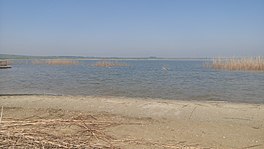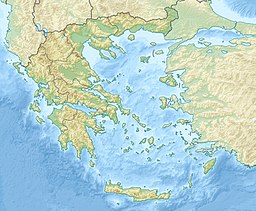
Back Горчиво езеро Bulgarian Πικρολίμνη Greek Pikrolímni Finnish Pikrolímni (lac) French Горчливо Езеро Macedonian Пикролимни (озеро) Russian Pikrolímni (sjö) Swedish 皮克罗林尼湖 Chinese
| Pikrolimni | |
|---|---|
| Πικρολίμνη (Greek) | |
 View of lake Pikrolimni | |
| Location | Kilkis, Central Macedonia, Greece |
| Coordinates | 40°50′05″N 22°48′46″E / 40.83472°N 22.81278°E |
| Type | hypersaline lake |
| Etymology | "Bitter lake" (in Greek) |
| Primary inflows | none (endorheic) |
| Catchment area | 42.5 km2 (16.4 sq mi) |
| Basin countries | Greece |
| Designation | Natura 2000 protected area CORINE biotope |
| Max. length | 2.4 km (1.5 mi) |
| Max. width | 2.3 km (1.4 mi) |
| Surface area | 3.7 km2 (1.4 sq mi) (average) |
| Average depth | 0.7 m (2 ft 4 in) |
| Max. depth | 1.5 m (4 ft 11 in) |
| Salinity | 153‰ |
| Shore length1 | 8.5 km (5.3 mi) |
| Surface elevation | 50 m (160 ft) |
| Frozen | never |
| Settlements | Nea Filadelfeia Mikrokampos |
| Website | Natura 2000 SDF |
| 1 Shore length is not a well-defined measure. | |
Lake Pikrolimni (Greek: Πικρολίμνη 'bitter lake') is an endorheic, alkaline salt lake in Kilkis prefecture, Greece.[1][2] It is located on the border of the Kilkis and Thessaloniki regional units, about 40 km northwest of Thessaloniki.[2][3] The lake is hypersaline, has rather shallow waters (0.5–0.7 m) and a shoreline of about 8.5 km.[3][4] The water surface area shows significant seasonal variation (3.2–4.5 km2) due to evaporation in the summer months, with an average value of 3.7 km2.[1][4]
Pikrolimni is the only salt lake in Greece and constitutes a biotope with rare halophytic vegetation surrounded by common reeds, which is home to various common and endangered bird species.[3][4][5] The habitat has been listed since 1996 as a Natura 2000 site of community interest and special protection area, while also protected by the Ramsar convention.[5]
The lake was known in ancient times as Chalastra (Ancient Greek: Χαλάστρα), a famous source of natron and trona for Graeco-Roman glassmaking.[1][6] In modern times it has been a site of pelo- and balneotherapy, with a spa specialising in such treatments using the lake's briny water and characteristic black mud.[2][7]
- ^ a b c Dotsika, E.; Poutoukis, D.; Tzavidopoulos, I.; Maniatis, Y.; Ignatiadou, D.; Raco, B. (2009). "A natron source at Pikrolimni Lake in Greece? Geochemical evidence". Journal of Geochemical Exploration. 103 (2): 133–143. Bibcode:2009JCExp.103..133D. doi:10.1016/j.gexplo.2009.08.003. ISSN 0375-6742.
- ^ a b c Dimopoulos, G.; Myriounis, Ch.; Mattas, Ch. (2009). "Contribution to the Investigation of the Origin of Salinity in Pikrolimni Lake, Central Macedonia". Ydrogaia: Collection in honour of Prof. Ch. Tzimopoulos (PDF) (in Greek). Thessaloniki: Ziti Publications. pp. 377–388.
- ^ a b c "LIMNI PIKROLIMNI (GR1230001)". Natura 2000. European Environment Agency. Retrieved 2021-04-03.
- ^ a b c "Pikrolimni". Natura Graeca, Guide to Greek Wilderness (in Greek). Retrieved 3 Apr 2021.
- ^ a b "LIMNI PIKROLIMNI - XILOKERATEA (GR1230004)". Natura 2000. European Environment Agency. Retrieved 2021-04-03.
- ^ Cite error: The named reference
:5was invoked but never defined (see the help page). - ^ Sofianska, E.; Athanassoulis, C.; Tarenidis, D.; Xirokostas, N.; Gkagka, M. (2019). "Textural, Mineralogical and Geochemical Assessment of the Pikrolimni Lake Sediments (Kilkis District, Northern Greece) and Suitability for use in Pelotherapy". Bulletin of the Geological Society of Greece. 55 (1): 170–184. doi:10.12681/bgsg.21080. ISSN 2529-1718.
© MMXXIII Rich X Search. We shall prevail. All rights reserved. Rich X Search
